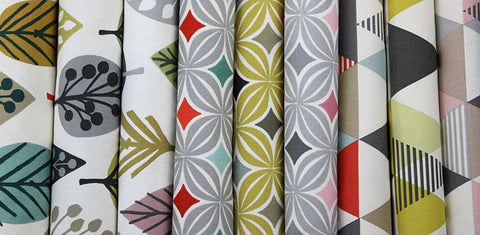
Which Style?
Choosing window dressings can be a bewildering experience with many fabrics and styles to choose from. The first decision to make is to decide on curtains or blinds for your window; the two offer radically different styles that can alter the entire way in which your room is experienced. Blinds - whether Venetian, Roman or Roller - offer a "tidier" and more minimalist look by creating a flat surface transition between the room and the window - this is ideal for a room where the overall aesthetic is clean and simple. Blinds can also work well where you're working to constraints - elegant and effective blinds, can be found at very reasonable prices, and they require minimal upkeep.
Curtains, on the other hand, offer a decidedly more lavish and sumptuous appearance. Because of the nature of the pleated fabric, they create a "soft" edge between the window and the room, which is ideal for ornamented or decorated rooms where the primary aesthetic is not merely a natural look but a carefully-orchestrated one. It's not just aesthetics though - they can often be far superior at shutting out all light (particularly blackout curtains or those with an additional liner), and use of heavier fabrics can mean curtains can be more energy-saving in a way that blinds, with their inherent gaps and requirement for thinner material, simply can't.
Within the category of curtains, there is a huge amount of variety of styles too. The main way in which these different styles can be categorised is based on the "header" which is how the curtains are made to hang, Consider what style of pleats you'd like - the most common are "pinch pleated", where the pleats are stitched together at the top, giving the curtains an elegant flow. Other options include the more solid-looking box pleats or elegant pinch pleats. For a casual and relaxed look, a more contemporary option is eyelet curtains. These dispense of pleats altogether, with eyelets built into the panels themselves, and are ideal for bedrooms or offices.
Fabric Choice
When thinking about the right fabric choice for your curtains, a useful gating question is to consider how much light you'd like to bring into your room during evenings and mornings when there may still be light outside. One consideration here will be how much natural light there is in the first place - if your room faces to the east for example, you're likely to have a lot outside your window in the morning, and that might lead you to opt for blackout curtains so the sunshine doesn't wake you up.
The three most commonly used fabrics for curtains are linen, cotton and velvet. Linen is a naturally light fabric, and this means it's often sheer and translucent; ideal for an airy feel or in warm sunny climates, but less suited where the rest of the room is designed in a more opulent fashion. Linen is also durable and lightweight, meaning it can be a joy to have when the window behind is open as it'll allow some breeze - it's best to pick neutral block colours like cream, sky-blue or flax when using linen curtains.
For more developed textures - potentially even with tassels and other textural features - cotton can be a better choice. It's just as robust as linen but decidedly sturdier; this means that it's commonly used by manufacturers for patterned curtains. Be mindful, though, that for optimal light occlusion with cotton curtains it's best to pick something with a liner. This will also ensure they don't fade due to sunlight exposure. On the other hand, velvet curtains can offer a "blackout" look and their smooth texture works well if you've incorporated velvet into other aspects of your room.

Patterns
Patterned curtains can add texture and visual interest to a room, and can even make it seem bigger than it is through trompe d'oeil. Patterns aren't for everyone, and certainly don't lend themselves to minimalist decor, bold primary-coloured stripes aside. However, they remain a popular pick and are regularly a stunning addition to a room.If your room is already elaborately decorated, it's best to choose a simple but classy pattern so as not to overwhelm inhabitants; bold patterns work best when the intention is for them to become the focus of a room. Floral and natural patterns are also increasingly popular - these are timeless and can enhance a room that is already themed along those lines. For example, if you enjoy keeping fresh flowers daily in your room, a gentle floral pattern can enhance that theme in a subtle but effective way.






Hinterlassen Sie einen Kommentar